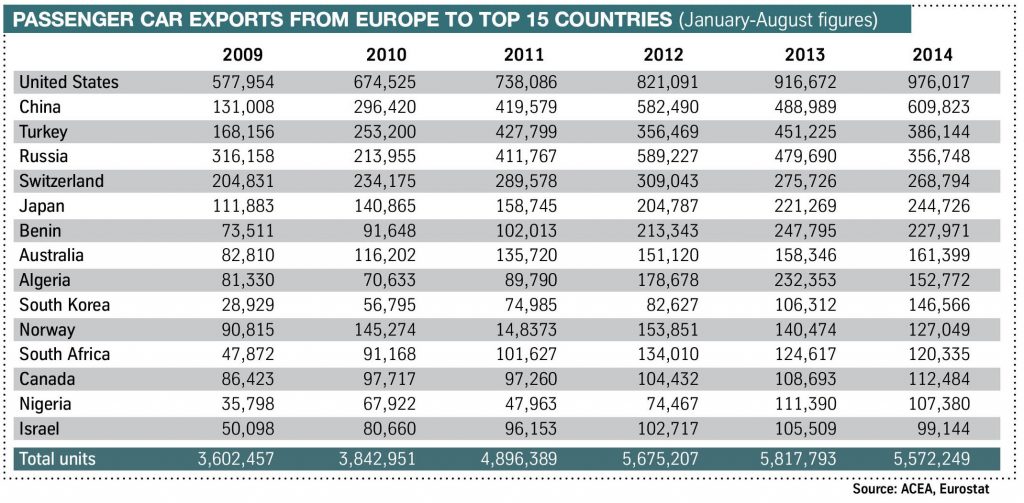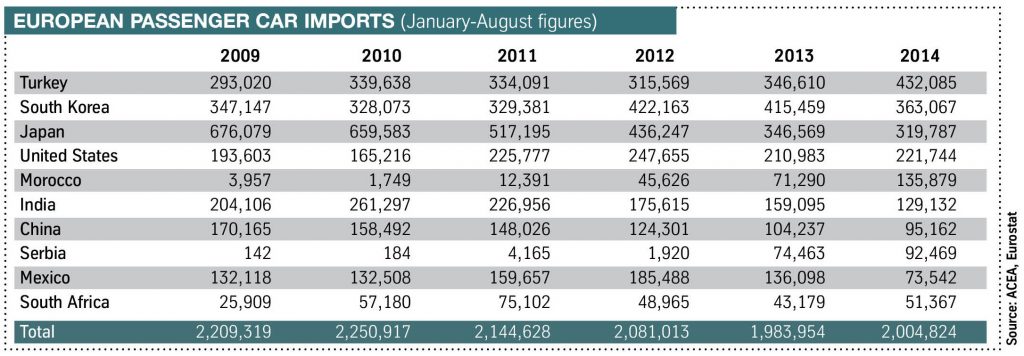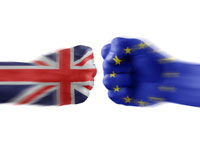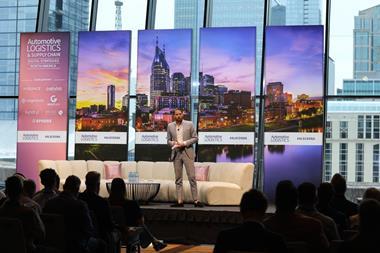 The European manufacturer’s association, ACEA, is a strong voice in Brussels and abroad, particularly in shaping regulations and trade deals. Erik Jonnaert (pictured) talks to Christopher Ludwig about how he would like the EU to help unlock innovation and export potential
The European manufacturer’s association, ACEA, is a strong voice in Brussels and abroad, particularly in shaping regulations and trade deals. Erik Jonnaert (pictured) talks to Christopher Ludwig about how he would like the EU to help unlock innovation and export potential
Erik Jonnaert is arguably one of the European Union’s most powerful lobbyists. Since October 2013 he has been secretary general of the European automobile manufacturer’s association, ACEA, which represents the bulk of production, sales and trade for passenger and commercial vehicles across the continent, and is an influential voice in the EU’s foreign trade negotiations as well on vehicle emissions and safety standards.
Jonnaert took over the role in October 2013 after a legal career and 25 years at Procter & Gamble, where he held a top post in public affairs. At ACEA, he navigates between fierce industrial competition and the often tougher personalities of what he calls global “captains of industry” – the chief executives and presidents who constitute ACEA’s 15 board members. The organisation’s current president, Renault Nissan CEO Carlos Ghosn, is the third Jonnaert has served since joining ACEA, following Fiat’s Sergio Marchionne and several months with Philippe Varin before he stepped down as CEO of PSA Peugeot Citroën.
Jonnaert is involved in negotiating important European policy for the automotive industry, such as rules affecting product innovation and international trade deals. Like the European industry itself, Jonnaert’s focus is very much global. After we first met in Amsterdam for the annual conference of the Association of European Vehicle Logistics (ECG), Jonnaert flew to South Korea to negotiate opening up parts of the market that some OEMs feel are still closed, despite the free trade agreement in effect since 2011. When we later speak at greater length, he is in Dubai for a meeting with the World Economic Forum on setting the agenda for next year’s global summit in Davos.
Jonnaert admits that, although it is vital to his members’ business and cost base, influencing logistics operations is not part of the day-to-day agenda for ACEA. A workshop group initiated several years ago between OEMs and logistics providers at ACEA has faded away. However, Jonnaert has agreed to align interests in logistics policy and regulation to those of his members where relevant; he supports ECG on topics such as harmonising vehicle carrier loading lengths and other weights and dimensions rules for European trucks. He also believes that promoting a greener supply chain is good for the sector, although this should be done “holistically”, including the use of fuel-efficient technology and educating drivers on fuel-saving behaviour, he says.
Influencing the supply chain
While ACEA focuses on policies that impact manufacturers directly, these are often relevant to managing logistics. Examples include negotiations on vehicle CO2 emissions standards, which were concluded last year, but are liable to be debated further when the new European Commission takes office. Such regulations cascade across the supply chain, impacting sourcing and equipment decisions. ACEA is also seeking more EU support for alternative powertrains through investment in appropriate infrastructure, such as for electric vehicle charge points, and natural gas and hydrogen fuelling stations.
Perhaps most significant is Jonnaert and ACEA’s role in negotiations for free trade agreements (FTAs). The EU is currently discussing FTAs with Japan, which is the leading exporter of passenger cars by value to the EU, and the United States, the top destination for EU-built motor vehicles. In both cases, negotiating tariff and regulations for automotive will be critical and complex. Jonnaert also feels that lessons from past experiences are important in these new deals, including from the somewhat soured Korea FTA and the Transatlantic Business Dialogue with the US, which began in 1995 but failed to produce tangible results for automotive trade.
For a sector emerging from six years of declining sales, it is hard to imagine a time when so much has been at stake. Jonnaert wants to ensure that regulations are not too burdensome, and at the same time that sales and export opportunities are unlocked. Logistics managers will be among those watching negotiations carefully.
The most research, the most regulations
Christopher Ludwig: Considering your background, what are the similarities and differences in advocating on behalf of automotive compared to fast-moving consumer goods (FMCG)?
Erik Jonnaert: Both sectors are very visible since they are close to consumers and public opinion. They are also scrutinised more than other sectors. However, one of the things I’ve found quite different in the auto industry is that it is much more heavily regulated than FMCG and others.
Secondly, I’ve been impressed by the high level of innovation in the auto industry. If you look at the figures, automotive is Europe’s number one investor in research and development, investing over €32 billion ($40 billion) per year. Not many people would realise that we invest more than biotech or high-tech, for example, but in Europe, automotive is ahead of the game.
Carmakers are localising production in other regions. Is there a risk innovation spending will leave Europe?
ACEA members are all global players. Several of them are headquartered in Europe and keep major hubs here for research. However, growth markets are primarily outside Europe and we will continue to see investment in places like Asia, including in research, in order to better reflect different market behaviours and preferences. But this investment won’t be to the detriment of Europe; it will go on top of what OEMs already do.
What are ACEA’s most important objectives in 2015?
I would point to three key priorities for the sector: investment in innovation; growth in international trade; and the need for a smarter, simplified regulatory framework.
For innovation investment, our big focus is on greener vehicles, as well as advances in safety and connected vehicles. As such, we have requested that the European Parliament and Commission focus upstream research funding in these areas. For us to invest in more sustainable technology, for example, we need governments to support the right infrastructure, such as recharging stations for electric vehicles and other alternative powertrains.
The second focus area is to grow through international trade. Sales are picking up, but Europe is a mostly saturated market. Most growth will come from elsewhere. The EU exported 6.6m vehicles in 2013, which contributed to an important trade surplus of €95.1 billion. Free trade agreements are important for our exports, which is why the FTA between the EU and US as well as negotiations with other growing markets are so important.
Finally, we are asking lawmakers in Europe to simplify regulations, and implement first the ones that are on the books before proposing new ones. If we compare the regulatory environment in Europe to many others regions, we see negative impacts on our industry as well as other sectors.

We hear there are discussions about setting new targets after the quite ambitious targets for CO2 reductions agreed for 2021 just last year. We need to make sure that while the industry continues to do its bit, the pace at which this continues in the future is in sync with what is happening globally. If all OEMs succeed in meeting the 2021 target of 95 grams of CO2 per kilometre for passenger cars, the automotive industry would have reduced EU emissions among its fleet by 49% between 1995 and 2012. To get to the 2021 target, we have to reduce emissions by 5% per year. That is a lot when you consider other sectors do it at 1% per year, and at a lower cost than automotive. Given the fact that we are in a competitive sector, we cannot transfer all of these costs to the end consumer.
ACEA members understand that we have to contribute further to emissions reduction and we support the overall objective to help address the

Fleet renewal and ‘holistic’ emissions reduction
Do you think there should be more focus on renewing the existing fleet of vehicles?
It is not only by setting ever-more aggressive CO2 standards that you reduce overall emissions from transport. Only 10% of the current European fleet is made up of new vehicles. Even with the most aggressive target, such as zero emissions for new vehicles, you would force

We also believe the focus on emissions should be done in an integrated way. Overall transport CO2 emissions are the result of a combination of factors related to the vehicle, but also to the mileage made by the customer and his or her driving style, the lifetime of the vehicle, the market share of alternative powertrains, upstream emissions of the energy sector and the carbon content of the fuel used. All these factors, which are beyond the manufacturers’ responsibility, should be examined in greater depth before any new proposal for vehicles are made.
For example, we’ve done studies through Transport and Mobility Leuven in Belgium to explore the potential of such an integrated approach to further reduce CO2 emissions from heavy-duty trucks, the results of which show that we could double our annual emissions reduction if we joined forces across all stakeholders, including manufacturers of trailers and tyres, suppliers and road operators.
It could also be of interest to policymakers to look at how we could exchange best practices across member states or more strongly harmonise incentives to allow for a more constant fleet renewal, which would help reduce emissions.
Making free trade fairer
ACEA members have complained that South Korea continues to restrict the market even with the FTA in place. Do you see scope to make the agreement fairer?
You always need to be hopeful and never close the door, which is why we continue to talk to our Korean friends together with the European Commission, to make sure the FTA is implemented correctly. It’s true that there are issues. It is not easy for a market that has traditionally been focused on its own producers to accept more competition. Since the FTA, we have seen more exports into Korea from Europe, but that is mainly for German premium brands. Otherwise, there are restrictions that have not been lifted.
The other way around, we have seen more Korean imports. In 2013, we had around 4.4% more than in 2012. We think it is important that there is a level playing field, so if the EU gives a fair chance, the same must happen in Korea.

The Commission and member states have given the green light for negotiations to continue beyond the first year. Japan is a declining market and relatively small in terms of opportunity for European exports. At the same time, it is a large exporter to Europe. When you look at trade flows between Japan and the EU, Europe imposes tariffs on imports from Japan, while there are no tariffs in Japan for imports from the EU. There are, on the other hand, many non-tariff barriers, so our negotiations are focused on these and on regulatory convergence. Here we are trying to learn from the mistakes of the Korea FTA in the rules we set.
Similar to Korea, European premium brands have success in Japan, but there is not much room for volume manufacturers. Around 40% of the Japanese passenger car market is made up of kei cars – mini cars. This segment is closed to imports by unique requirements for vehicle and engine size. We want to make sure European volume manufacturers in the business of small vehicles would be given a fair chance to compete.
I understand the US-EU agreement depends on accepting corresponding safety standards on both sides, before harmonising them later. Just how complex would this be?
First of all, this agreement is a different ballgame than that of Japan and Korea, since the US and EU markets are of a similar size and similarly advanced. Together the two make up more than half of the global vehicle market, while automotive makes up 10% of the total trade between the two regions.
It is also not the first time that Europe has sat with the US to discuss free trade agreements for automotive. We tried it with the Transatlantic Business Dialogue, when the focus was to harmonise regulation on both sides. That didn’t work and we have to learn from the past. This time, rather than focusing on harmonisation, we are pushing for mutual recognition of each other’s regulations. We would like to move to a situation whereby cars that are certified in Europe in line with EU safety standards would be accepted in the US without additional testing, and vice-versa. Only in the future will we look to harmonise jointly on the basis of UN standards.
It is complicated because the certification process is different in both regions. The US uses a self-certification system, while in EU we have a type-approval method. However, both markets have high standards when it comes to safety and environment.
To do this, the industry has appointed consultants on both sides of the Atlantic. In the US we are using experts from the University of Michigan; in Europe it is Chalmers University of Technology in Sweden. Both are working on a methodology to help establish equivalency of safety regulation, including analysis of accident data. By the end of 2014 we will hopefully know the outcome of that exercise.

We are not asking for lower standards here or in the US. The outcome of the exercise would be that the FTA would recognise the equivalence of both sides’ safety regulations for passenger cars. For commercial vehicles, we seek mutual recognition between Euro VI and EPA 10, focusing initially only on emissions.
Finally, what is your vision for keeping the EU automotive sector competitive in a globalised world over the next decade?
Like any other sector, we have to keep costs under control in Europe. This includes reducing cost from manufacturing, but also reducing negative cost implications from new regulations. We are committed, as a sector, to continue investing in vehicles that are ever safer and cleaner. At the same time, we should avoid that the European automotive industry has to implement standards that are stricter than the rest of the world. Above all, we have to keep our industry competitive: this will be key for growth and jobs in the automotive industry in Europe.
 European vehicle sales in 2014 saw welcome, albeit mixed growth. Passenger sales were up 6% in the first ten months compared to 2013, while truck sales were up around 9%. The growth, however, is from a very low base and the story changes by market: the rise was compelling in the UK and Spain, but less robust in France and Italy.
European vehicle sales in 2014 saw welcome, albeit mixed growth. Passenger sales were up 6% in the first ten months compared to 2013, while truck sales were up around 9%. The growth, however, is from a very low base and the story changes by market: the rise was compelling in the UK and Spain, but less robust in France and Italy.
Erik Jonnaert emphasises that this disjointed picture is down not only to different economic conditions, but also national government responses. Spain, for example, has a successful scrappage scheme. At the same time, the country has managed to lower labour costs, making its production and exports more competitive.
The British market has dynamics that make its recovery specific, including cheap financing and a large share of vehicle purchases for business and rental fleets. However, Jonnaert also credits part of the success to initiatives of the UK Automotive Council, a cross-sector grouping of OEMs, suppliers, regulators, dealers groups and others. Created in 2009 during the crisis, the council has encouraged dialogue and action for industry issues, including supplier localisation and access to financing.
According to Jonnaert, it’s a model that other European countries should be exploring, as each sector needs specific focus from governments.
“Italy has been looking at the UK model in hopes of applying something similar,” he says. “There is no one-size-fits-all proposal. We applaud the European Commission’s commitment to a single market in Europe, but at the same time you need a sector-by-sector approach to enhance competitiveness.”
While the UK has been a shining example for automotive, it faces a potential existential threat. With euro-scepticism on the rise, and the prospect of a UK referendum on EU membership, the chances it will leave the club have increased. The subsequent impacts of a ‘Brexit’ on free trade with Europe are unknown, however they are potentially devastating for automotive supply chains.
The EU is the UK’s largest market for vehicles and also the source of many of its components for production. A study by the UK carmaker’s association, SMMT, highlighted how critical EU membership is to the sector, including access to free trade agreements with growing global regions beyond the continent. In the report, 92% of automotive business in the country said it would be beneficial to stay in the EU.
“If the UK were to step out of the EU, I think it would be a risk for a lot of OEMs with production in the country,” Jonnaert says. “I also think it would not be a good thing for the UK itself.”





































